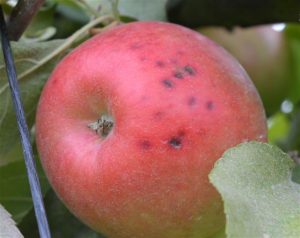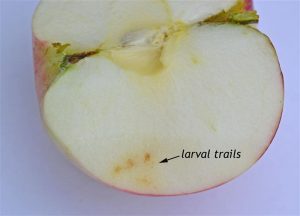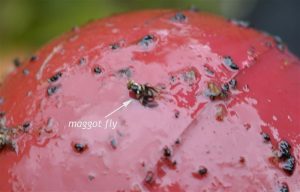We’ve had several customers call after noticing that their apples (or pears) have apple maggot in them this year. The most asked question is, “What can I do now to prevent this from happening next year?”
We’ve posted in the past how to time sprays for apple maggot. Unfortunately, if you’re using organic controls, it only takes being a day off to have some damage occur. What most orchardists want is to minimize the amount of maggots every year.
First, do you have maggots in the fruit? Some of the fruit on the tree may have black or brownish spots dimpling the surface. These definitely could mark the site an egg was laid and a larvae (maggot) hatched and entered the fruit. The picture here is pretty heavily ‘stung’, and some of the spots look like there are holes through the skin.
Cut open the fruit and look for larval trails. The maggot itself is quite small, but as it munches its way through the apple, the trails turn brown, discoloring the flesh.First, do you have maggots in the fruit? Some of the fruit on the tree may have black or brownish spots dimpling the surface. These definitely could mark the site an egg was laid and a larvae (maggot) hatched and entered the fruit. The picture here is pretty heavily ‘stung’, and some of the spots look like there are holes through the skin.
Strategies for the home orchardist who finds apples with maggots, SANITATION:
- Pick up all fruit as it falls- do not let it stay on the ground!
- Feed the fallen fruit to cows, pigs, or throw in the garbage.
- Do not compost (unless you cook it first). The larvae can survive home compost temperatures.
- If you have chickens or guinea fowl, consider letting them forage under your apple trees. Pigs can also be pastured just after harvest under the trees to clean up (with care, they can damage the trees if left there after the fruit is gone).
- Flame weeding under your trees in fall and early spring can help reduce the overwintering larvae population.
After spraying, if you continue to get additional flies on the traps, you may need to spray again. For most home orchards, sanitation plus one or two sprays will control most of the maggot problems.Next spring, hang traps by early July, and check every couple of days for adult flies. Use this in conjunction with the models to time spraying.
If you have neighbors with trees, consider talking to them about controlling apple maggot. The flies do not respect property lines!





I would really appreciate more information on organic control of apple maggots. They moved into my orchard two years ago and I am struggling to figure out how to combat them. I am focusing on cleanup and booties but they are labor intensive.
So far, using degree day models for timing to spray organic pesticides has been most effective for us. We have tried spraying kaolin clay as a preventative- repeat applications are necessary and are not 100% effective. We are hoping to do a trial this summer using insect netting over several rows to try to control both apple maggot and codling moth. Stay tuned for updates.